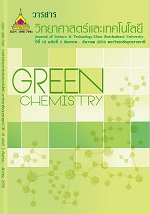กายวิภาคศาสตร์เนื้อเยื่อชั้นผิวใบของพืชวงศ์มะขามป้อม (Phyllanthaceae) บางชนิดในประเทศไทย
Main Article Content
บทคัดย่อ
Leaf Epidermal Anatomy of some Species of the Family Phyllanthaceae in Thailand
This study aimed to identify the epidermal features that can be recognized and employed as useful taxonomic characters. Leaf epidermal studies were carried out on 23 species of 10 genera of family Phyllanthaceae occurring in Thailand. The species investigated included six species of Phyllanthus, four species each of Antidesma and Glochidion, two species of Baccaurea and Sauropus, and one species each of Aporosa, Bridelia, Cleistanthus, Hymenocardia, and Margaritaria. The specimens were prepared by leaf epidermal peeling and clearing methods, and stained with 1% safranin. The generalized anatomical characteristics of the family were as follows: 1) the patterns of cuticle were smooth or striate; 2) the shapes of epidermal cells were polygonal, irregular, or jigsaw-like; 3) the types of stomata were anomocytic, anisocytic, paracytic, cyclocytic, laterocyclic, or mixed between paracytic and actinocytic; 4) the types of trichomes were unicellular hairs, peltate hairs, or papillae, and 5) the types of inclusions were druse crystal, prismatic crystal, tannin, or red cell inclusion, and secretory cavities were presented in some species. The above mentioned leaf features are of great taxonomic significance, able to be used to identify some species or genera.
Article Details
บทความที่ได้รับการตีพิมพ์เป็นลิขสิทธิ์ของ วารสารวิทยาศาสตร์และเทคโนโลยี มหาวิทยาลัยอุบลราชธานี
ข้อความที่ปรากฏในบทความแต่ละเรื่องในวารสารวิชาการเล่มนี้เป็นความคิดเห็นส่วนตัวของผู้เขียนแต่ละท่านไม่เกี่ยวข้องกับมหาวิทยาลัยอุบลราชธานี และคณาจารย์ท่านอื่นๆในมหาวิทยาลัยฯ แต่อย่างใด ความรับผิดชอบองค์ประกอบทั้งหมดของบทความแต่ละเรื่องเป็นของผู้เขียนแต่ละท่าน หากมีความผิดพลาดใดๆ ผู้เขียนแต่ละท่านจะรับผิดชอบบทความของตนเองแต่ผู้เดียว


